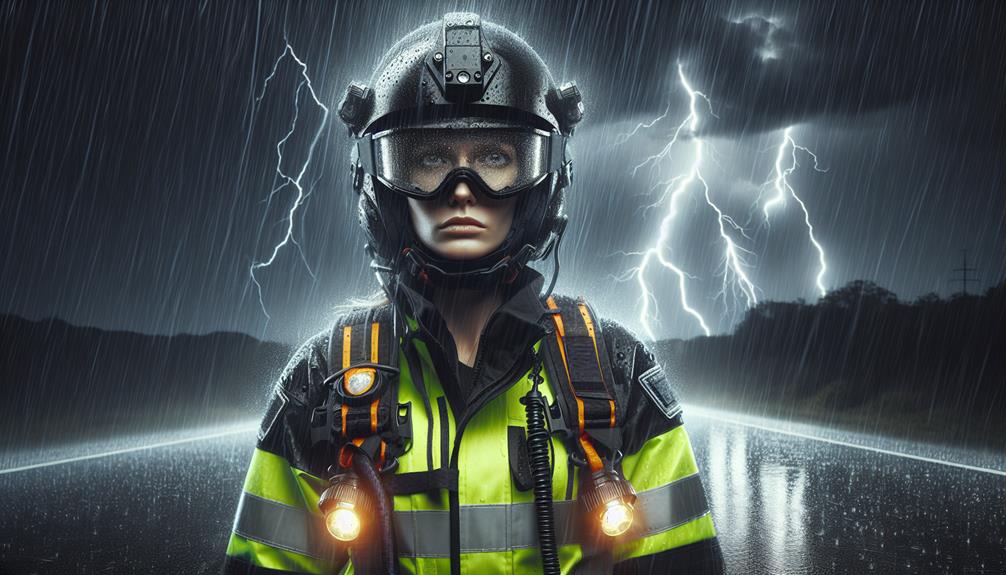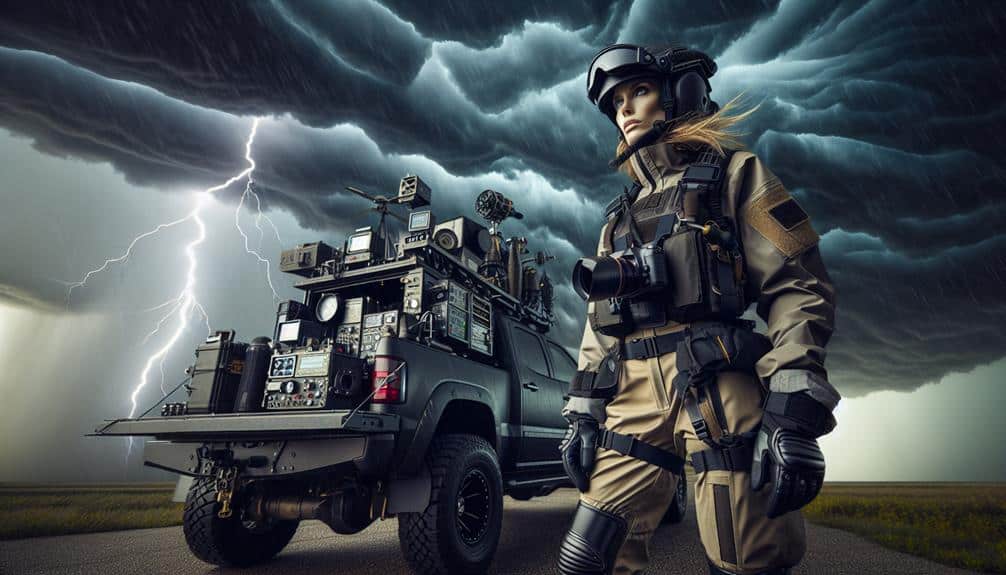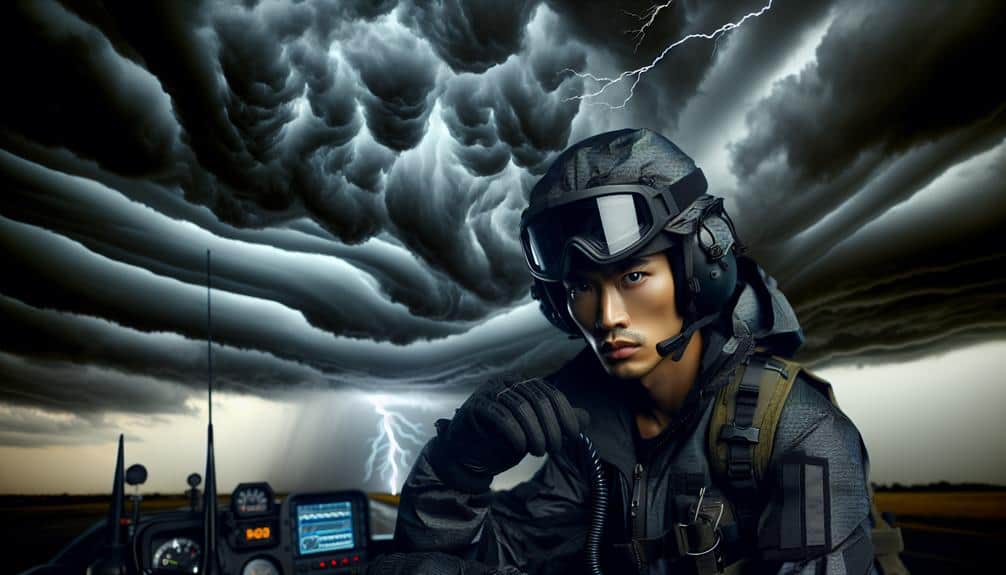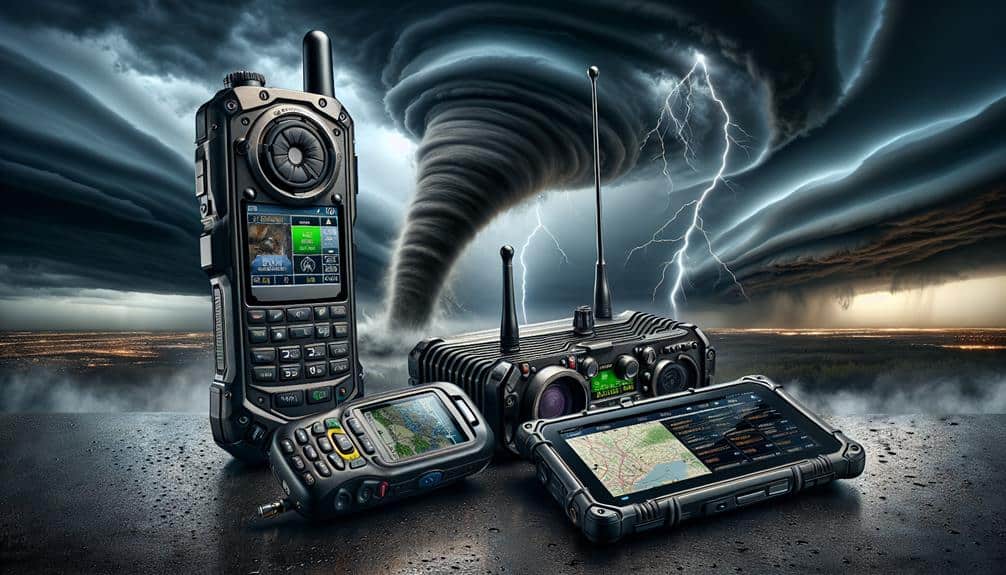We prioritize personal protective equipment (PPE) for storm chasers to mitigate severe risks like high winds, flying debris, and electrical hazards. Our gear includes high-impact helmets, reinforced gloves, and weather-resistant suits, which protect us from environmental extremes. We utilize GPS tracking, LED lights, and portable air quality monitors to enhance safety and operational efficiency. By incorporating high-tensile strength harnesses and dielectric properties in our equipment, we safeguard ourselves from physical and electrical threats. PPE not only secures our mobility and comfort but also extends our operational window, allowing us to gather critical data under hazardous conditions. Explore more to understand our safety measures.
Key Points
- Protection from High Winds: Wind-resistant gear shields storm chasers from the force of high winds, minimizing injury risks.
- Debris Shielding: High-strength body armor and shatterproof eye protection protect against flying debris during severe weather events.
- Electrical Hazard Safety: Gear with dielectric properties guards against electrical hazards, ensuring safety in lightning-prone conditions.
- Enhanced Visibility: Reflective gear and LED lights improve visibility in low-light conditions, preventing accidents and enhancing operational safety.
Protecting Against High Winds
When facing high winds, storm chasers must equip themselves with wind-resistant gear such as reinforced helmets and aerodynamic, snug-fitting outerwear to minimize drag and prevent injuries.
First, our helmets should be made with high-impact resistant materials like polycarbonate or composite blends to shield our heads from potential hazards. At the same time, these helmets should include built-in rain protection, ensuring we maintain clear visibility despite heavy downpours.
Next, the outerwear we choose is vital. It needs to be both wind-resistant and thermally insulated. Aerodynamic designs reduce wind drag, allowing us to move efficiently even in gale-force conditions. Additionally, thermal insulation is crucial to maintain our core body temperature, preventing hypothermia in cold, stormy environments. Fabrics like Gore-Tex or eVent offer excellent wind resistance while remaining breathable and waterproof, providing thorough rain protection.
Moreover, attention to seams and zippers is essential. Double-stitched, taped seams and waterproof zippers prevent water ingress, ensuring we stay dry. Layers of high-performance materials should be considered to balance thermal insulation and breathability.
Shielding From Debris
To shield ourselves from airborne fragments, we need to use high-strength body armor and shatterproof eye protection designed to withstand impacts from projectiles. The unpredictable nature of storm environments means that debris can travel at high speeds, posing substantial risks. By wearing body armor with superior impact resistance, we reduce the chances of injury from flying objects, which can include anything from small pebbles to larger, more perilous items like metal fragments.
Facial protection is equally essential. Shatterproof eye protection, such as polycarbonate goggles, provides a strong barrier against airborne particles and prevents potential eye injuries. Additionally, full-face shields offer extensive coverage, safeguarding both our eyes and facial skin from debris impact. The integration of impact-resistant materials in these PPE items ensures that they can absorb and disperse the energy from high-speed impacts, reducing the likelihood of penetration injuries.
Furthermore, data from storm chasing incidents have shown that proper personal protective equipment notably decreases the severity of injuries sustained in the field. By prioritizing our safety with high-grade, impact-resistant armor and facial protection, we maintain our freedom to pursue storm chasing with a diminished risk profile.
Ensuring Mobility and Comfort
Balancing the need for sturdy protective gear with the necessity for mobility and comfort is crucial for storm chasers to perform effectively in dynamic environments. We depend on weather monitoring equipment that requires quick access and rapid deployment, making it crucial that our personal protective equipment (PPE) doesn't impede our movements.
Lightweight, breathable materials are vital in ensuring we can maneuver efficiently while maintaining focus on collecting accurate data.
Our gear must also seamlessly integrate with our safety measures. For example, ergonomic designs in helmets and gloves promote dexterity without compromising protection, allowing us to operate sophisticated weather monitoring instruments with precision. Advanced fabrics with moisture-wicking properties help manage perspiration, especially when we're exerting ourselves in high-stress situations.
Additionally, adjustable straps and customizable fits in our PPE are non-negotiable. These features guarantee that gear remains secure without restricting blood flow or causing discomfort during extended periods of use.
Guarding Against Electrical Hazards
Storm chasers must prioritize PPE with dielectric properties to effectively guard against electrical hazards encountered during severe weather events. As we navigate the volatile atmospheres of storms, electric shock becomes a noteworthy risk, especially when lightning strikes are prevalent. To mitigate this hazard, we need to adopt specific safety measures, including dielectric boots and gloves, which are designed to resist electrical conductivity.
Data indicates that dielectric gear can reduce the likelihood of electric shock by up to 90%. This type of PPE is crucial when working near downed power lines or electrified debris. We should also consider wearing dielectric helmets, which protect against potential electrical arcs. By incorporating these items into our standard gear, we enhance our overall safety and operational efficacy.
Moreover, it's crucial to regularly inspect our PPE for any damage or wear that could compromise its protective properties. Even minor defects can greatly reduce the effectiveness of these safety measures. As a result, maintenance checks should be a routine part of our preparation process.
Utilizing PPE with robust dielectric properties not only safeguards us against electric shock but also ensures that we can continue to chase storms with a higher degree of freedom and security.
Enhancing Visibility in Low Light

We must prioritize enhancing our visibility in low-light conditions. Reflective gear increases our detection by drivers by up to 300%.
While LED light attachments provide an additional 1000 lumens of illumination. These measures lessen the risk of accidents during nighttime storm chasing.
Reflective Gear Benefits
Reflective gear significantly enhances visibility in low light conditions, crucial for storm chasers navigating through perilous environments. When we're out tracking severe weather, our safety depends on being seen, especially by fellow chasers, emergency responders, and other vehicles. Reflective materials, integrated into our outerwear, act as a critical safety measure.
The high-visibility components of reflective gear notably improve our presence in dim, stormy settings, where reduced light and heavy precipitation can obscure our location.
The safety benefits of reflective gear can't be emphasized enough. Studies suggest that reflective clothing can boost visibility by up to 200% in low light conditions, decreasing the risk of accidents. This improved visibility allows us to concentrate more on data collection and less on potential hazards.
Combining these advantages with weather protection, such as water-resistant fabrics and windproof materials, guarantees we stay dry and comfortable, enabling us to operate for longer durations.
Incorporating reflective gear into our personal protective equipment not only maximizes our field safety but also ensures adherence to standard safety protocols. As we pursue our passion for storm chasing, it's crucial we prioritize our visibility and protection to continue enjoying the thrill of the chase securely.
LED Light Attachments
In addition to reflective gear, integrating LED light attachments into our equipment greatly enhances our visibility during low light conditions. These lights not only improve our ability to navigate treacherous terrains but also alert others to our presence.
The effectiveness of LED technology lies in its high lumen output and energy efficiency. By using LEDs, we can guarantee extended operational time without frequent battery replacements, an important factor when time is of the essence.
When it comes to safety precautions, LED light attachments play a pivotal role. Their strategic placement on our helmets, jackets, and vehicles ensures 360-degree visibility, reducing the risk of accidents. High-intensity LEDs can penetrate through rain and fog, providing a significant advantage in storm chasing scenarios.
Moreover, equipment maintenance becomes straightforward with LEDs. They require minimal upkeep due to their durability and long lifespan. Regular checks for battery life and secure attachment are essential but manageable tasks.
Incorporating LED lights into our gear complements other protective measures and maximizes our safety.
Prolonging Exposure Safety
To ensure prolonged exposure safety, storm chasers must meticulously monitor environmental conditions and utilize advanced personal protective equipment (PPE) designed for extreme weather scenarios. By incorporating real-time weather data and predictive analytics, we can effectively minimize risks and increase preparedness.
Our PPE should include high-impact helmets, reinforced gloves, and weather-resistant suits to shield us from debris and hazardous elements. Additionally, integrating portable air quality monitors and thermal imaging cameras helps us stay aware of toxic gases and sudden temperature fluctuations.
Using cutting-edge communication devices with GPS tracking systems guarantees that we're always connected with our team and emergency services, facilitating rapid response in case of sudden changes. Hydration systems embedded in our gear allow us to maintain peak physical condition during extended chases, while high-tensile strength harnesses provide necessary security against high winds and sudden turbulence.
Advanced PPE, combined with diligent environmental monitoring, enables us to extend our operational window safely. By wearing gear that's specifically engineered for extreme conditions, we not only safeguard our health but also enhance our ability to gather critical data. This approach empowers us to push boundaries safely and make the most of our storm-chasing endeavors.
Frequently Asked Questions
How Do Storm Chasers Communicate During Severe Weather Conditions?
We communicate using ham radios, satellite phones, and specialized apps. Communication challenges arise due to signal interference. Adhering to safety protocols, we guarantee reliable data exchange, essential for real-time updates and maintaining operational freedom.
What Training Is Required to Use Personal Protective Equipment Effectively?
Imagine a knight donning armor; we need rigorous training for proper handling of personal protective equipment. This includes understanding safety measures, practicing emergency protocols, and ensuring all equipment functions correctly to maximize our safety during storm chasing.
Are There Specific Guidelines for Maintaining Personal Protective Equipment?
Yes, we must follow specific guidelines for maintaining personal protective equipment (PPE). Proper upkeep includes regular inspections, following manufacturer instructions, and timely replacements. Inspection guidelines guarantee PPE remains effective, preserving our safety and freedom in the field.
What Psychological Impacts Do Storm Chasers Face, and How Can They Be Mitigated?
Facing storms is a mental rollercoaster. We need robust mental health, coping strategies, and stress management. Establish support systems with precise methodologies to mitigate psychological impacts and maintain our freedom to chase safely and effectively.
How Do Storm Chasers Monitor and Track Storms While on the Field?
We utilize advanced data collection technology, including GPS tracking and forecasting models, to monitor and track storms in real-time. This precise data enables us to navigate safely and effectively, maximizing our freedom and efficiency in the field.


